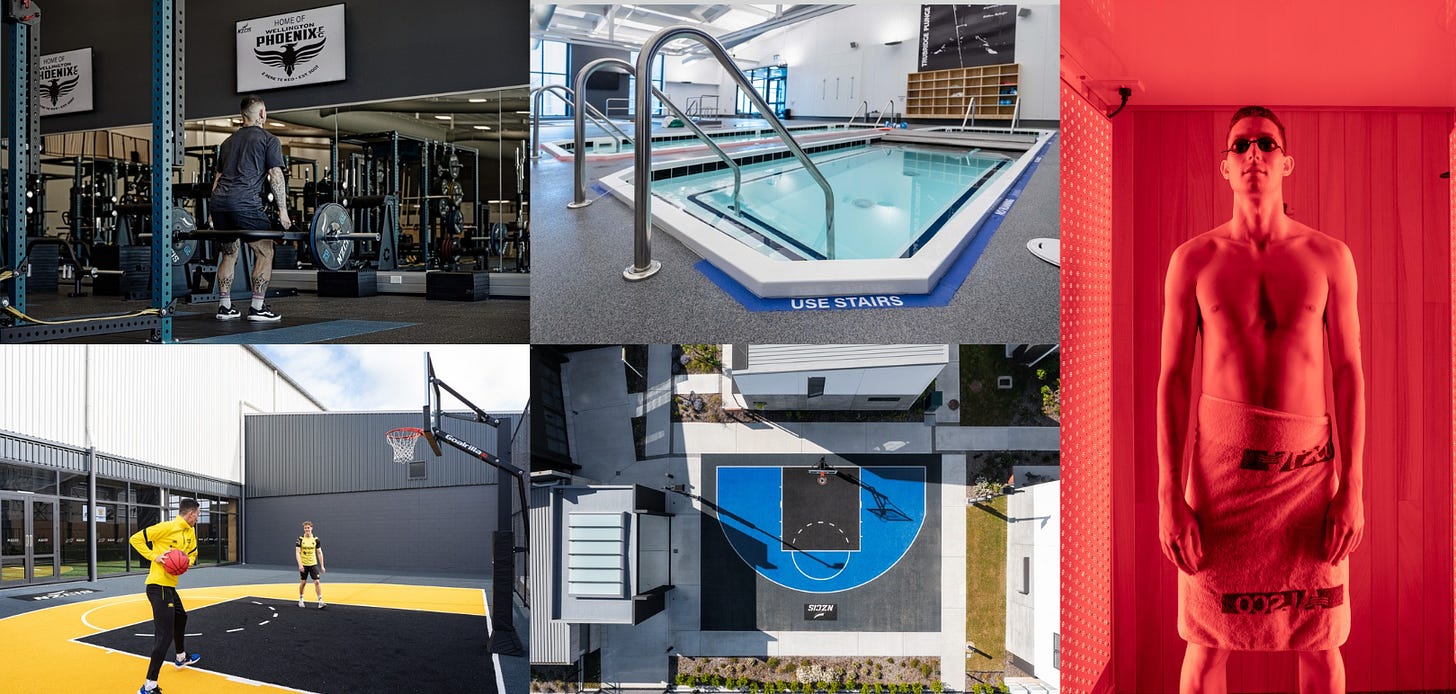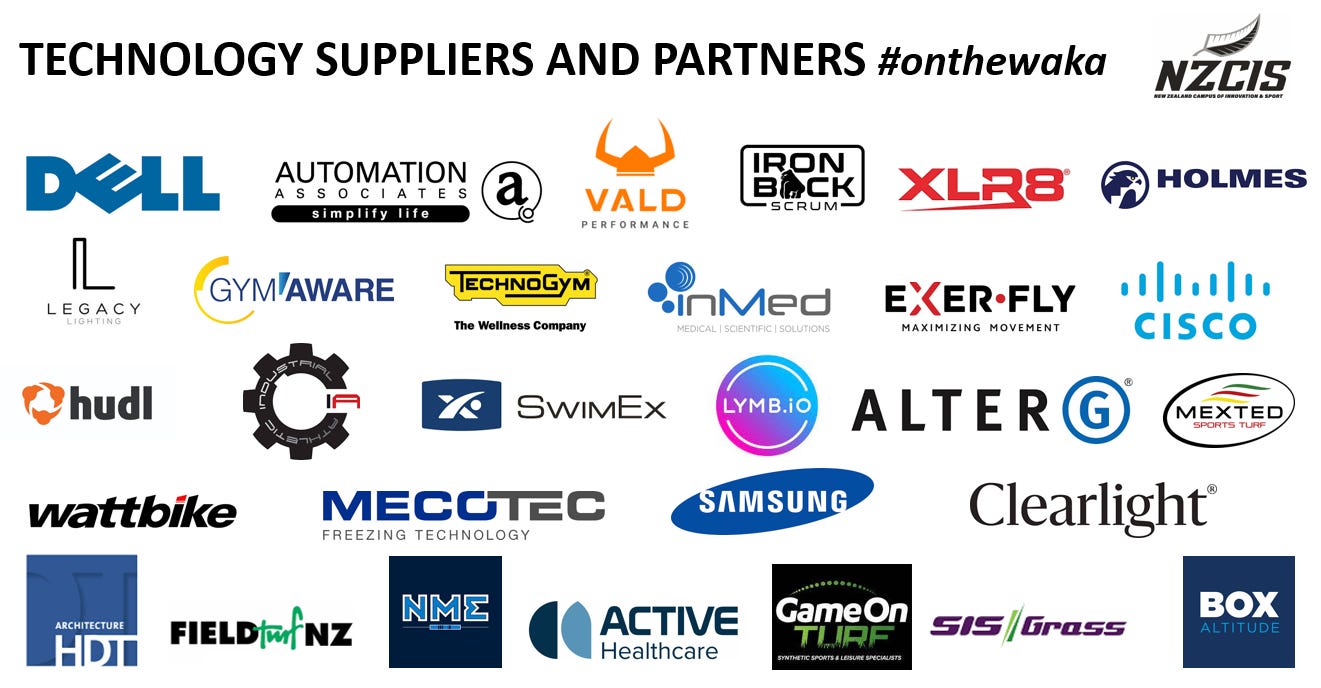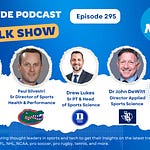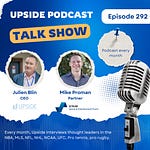Today we have the honor of interviewing Jamie Tout, GM of the New Zealand Campus of Innovation & sports, a shared resource campus where multiple teams such as the New Zealand All Blacks, Swedish women football team have been training.
The New Zealand Campus of Innovation and Sport (NZCIS) is a world-class high-performance facility designed to support elite athletes, teams, and organizations. Located in Wellington, NZCIS offers top-tier training fields, a fully equipped performance gym, an advanced recovery centre, specialized sports science labs, and on-site accommodation and dining services. The campus is also a hub for innovation, fostering collaboration between sports, business, and technology leaders. NZCIS provides unparalleled resources to optimize performance, accelerate recovery, and promote success for athletes and organizations.
NZCIS is home to top professional sports teams, including the All Blacks, Black Ferns, Phoenix Football, and Hurricanes Rugby (both men’s and women’s). Recently, we have built a state-of-the-art facility and are focused on strengthening international collaborations, particularly in areas like sports media, fan engagement, human performance, education, and marketing.
Pictures: NZCIS
Here is a quick video showcasing the NZCIS facility:
NZCIS has formed partnerships with professional rugby and football teams and is now the official training base for these teams. We have hosted international teams, like Sweden during the FIFA Women’s World Cup, and will be featured in upcoming FIFA guidelines.
The campus boasts over 400 beds, training facilities, and catering, making it a unique facility in the southern hemisphere. We are engaging with global sports clubs to learn from their design and explore potential partnerships and are now looking for a partners beyond just brand visibility, focusing on impactful collaborations in training, events, education, human performance, and marketing.
as illustrated below, NZCIS has teamed up with a number of key supply / partners over the years:
📝Show Notes: Through this interview, we touched on his background, his facility, the types of teams (NZ All Blacks, Swedish women national soccer team..) that have trained at his facility. He also touched on the importance of technologies, some of the technologies they use at his facility. Lastly he gave us his thoughts on where he sees the future of sports performance training evolving in the coming years.
You can read the full transcript of the podcast interview with Jamie located at the top of this blog post.
Here are the quotes from the interview with Jamie:
Q1. Can you tell me about your background?
"My background has been in sport for over 20 years now, covering everything from grassroots to professional teams. Over the last 15 years, I’ve spent a lot of time on the road, working with teams across multiple sports codes. That experience ultimately led me to this role, where I was introduced to Malcolm Gillies and Kevin Melville, who had a vision to build a shared resource campus for sport here in New Zealand."
"Before this, I was a strength and conditioning coach and worked in sports science, primarily in rugby, cricket, and netball. I also helped set up a small wearables company called VX Sport, which focused on tracking athlete performance. So, I’ve always been passionate about using data and technology to improve sports performance."
Q2. What makes your facility stand out compared to others in the area?
"What makes our facility truly unique is that we are a shared, multi-team campus rather than a single-team facility. We’re home to New Zealand Rugby, which includes the All Blacks and the Black Ferns, as well as the Hurricanes, the Phoenix men’s and women’s teams, and Wellington Rugby. This creates a dynamic training environment where multiple high-performance teams train alongside one another, sharing resources and best practices."
"Instead of paying for an outright lease, teams operate under a ‘license to occupy’ model. They let us know ahead of their season what facilities—fields, analysis rooms, pools, gym space—they will need, and they receive a bucket of hours to use accordingly. This model ensures efficient use of our 18-hectare campus while allowing flexibility for different teams and sports."
"Beyond sports, we also have a significant commercial presence, with over 20 floors of office space occupied by government tenants like the Department of Defence and the Ministry of Justice. We have on-site accommodation with over 400 beds and a full dining area serving up to 16,000 meals per month. So, we’re not just a training facility—we’re an integrated performance hub."
Q3. What types of teams have trained at your facility?
"While rugby and football have been our primary focus, we’re starting to see a lot more diversity in the types of teams and sports using our campus. For example, next month, the New Zealand swimming squad will be training here for an altitude training camp. We have four altitude apartments, each with two king beds, as well as a 140-square-meter altitude studio. Instead of going overseas for altitude training, they’re now choosing to stay in New Zealand."
"We’ve also recently secured the hosting rights for the Pacific Men’s Lacrosse Tournament, which will bring eight international teams here next January. Additionally, we’re co-hosting the Amateur PGA Women’s Golf Tournament, and we’ve formed partnerships with a nearby international golf course."
"Looking ahead, we’re working to establish partnerships with leagues like Major League Soccer, Japan’s J-League, and India’s Premier League, as we see significant potential in hosting preseason camps, tournaments, and training residencies for top-tier international teams."
Q4. What role does technology play in your training programs?
"Technology plays a fundamental role in how we operate. It’s in our name—the New Zealand Campus of Innovation and Sport—so we are committed to staying at the cutting edge of sports technology. That means both adopting new technology and using existing tools in innovative ways."
"We’ve built our facility with a dedicated data center to handle the vast amounts of video footage and performance data teams collect. Every wearable device an athlete wears can track up to one million data points every 90 minutes. In the gym, we use TechnoGym, GymAware, and VALD force plates to monitor strength and conditioning in real time, displaying data instantly on screens or personal devices."
"One of the key challenges with technology is avoiding ‘paralysis by analysis.’ It’s easy to collect too much data without having the human resources to interpret it properly. So, we focus on making data accessible and actionable—whether it’s for an athlete tracking their performance set-by-set, a coach making real-time adjustments, or a sports scientist analyzing long-term trends in injury prevention and recovery."
Q5. Can you give examples of how technology has helped improve athlete performance or injury prevention?
"A good way to think about injury prevention is that we need to build the fence at the top of the cliff while also making sure the ambulance is ready at the bottom. The first step is using technology to monitor workload and recovery so we can make informed decisions that help prevent injuries in the first place."
"When injuries do occur, technology is critical for rehabilitation. By using objective data on load management and recovery responses, we can safely return athletes to play in a shorter time while minimizing the risk of reinjury. Tools like cryotherapy, red light therapy, and plunge pools aren’t just available—they’re fully integrated into our workflows so athletes can use them efficiently."
"A simple but powerful example of technology in action is our TechnoGym rowing machines. Every rower in the gym is connected to a big screen, allowing athletes to compete against each other in real time. This taps into their competitive nature, increasing intensity and engagement, which ultimately leads to better training outcomes."
Q6. What recovery methods or tools do you incorporate into your programs?
"When we designed our recovery spaces, we didn’t just install equipment based on personal preference. Instead, we asked our foundation member teams—like the Hurricanes and the Phoenix—what they actually wanted. The first time we surveyed them, we got 48 different suggestions. We then had them vote, and the overwhelming top choice was hot and cold plunge pools."
"To validate our choices, we also surveyed 35 international teams, including Manchester United, PSG, and the New York Giants. In terms of recovery modalities we found that in the U.S. and Australasia, hot and cold therapy was most prevalent, while in Europe, cryotherapy was commonly used."
"Ultimately, the key to recovery technology is making it easy to access. If it’s too complicated or time-consuming, it won’t get used. That’s why we focus on streamlined, self-contained setups that allow athletes to get in, recover, and move on quickly."
Q7. What are the biggest challenges of managing a sports performance facility?
"The more moving parts you introduce, the more complicated it gets. That’s why we focus on complementary solutions rather than just adding more technology. Strong after-sales support and ongoing education are crucial to making sure the systems we invest in actually deliver value."
"Sometimes, the best approach is to keep things simple—less but more meaningful partnerships, and a strong focus on integration rather than fragmentation."
Q8. What partnerships or collaborations have helped grow your training programs?
"We take an agnostic approach to technology partnerships. For example, in GPS tracking, we work with multiple providers—Statsports, Catapult, VX Sport—because different teams have different needs. Similarly, in the gym, we chose TechnoGym because their user-friendly interface increases athlete engagement."
"Even things as simple as booking systems matter. When managing a large-scale facility, if your scheduling and logistics aren’t seamless, they can become a bottleneck. So, we’ve prioritized enterprise-grade solutions that integrate well with each other and ensure smooth day-to-day operations."
Q9. Where do you see the future of sports performance training heading?
"One of the biggest strengths of our facility is the cross-collaboration between different sports. When high-performance teams train side by side, they naturally learn from each other. That’s something we actively encourage."
"But beyond technology and facilities, we believe in a strong foundation of values—growth, connection, and adaptability. We see ourselves as a hammerhead shark: always moving forward, constantly adapting to change. The future of sports performance isn’t just about the latest gadgets; it’s about creating an environment where people and ideas thrive."
Q10. What is the best way to reach out to you to learn more about your facility, how to rent the space?
“The best way to reach him personally is via email at jamie.tout@nzcis.co.nz. Additionally, you can visit the facility’s website at nzcis.co.nz or connect through their social media, particularly on Instagram, Facebook, and LinkedIn”.
LinkedIn: www.linkedin.com/company/new-zealand-campus-of-innovation-and-sport
Facebook: https://www.facebook.com/NZCampusofInnovationandsport
Instagram: @nzcis_
You may also like:
🏉 📈 Upside Research: Non-contact lower limb injuries in Rugby Union: A two-year pattern recognition analysis of injury risk factors
Title: Non-contact lower limb injuries in Rugby Union: A two-year pattern recognition analysis of injury risk factors

















